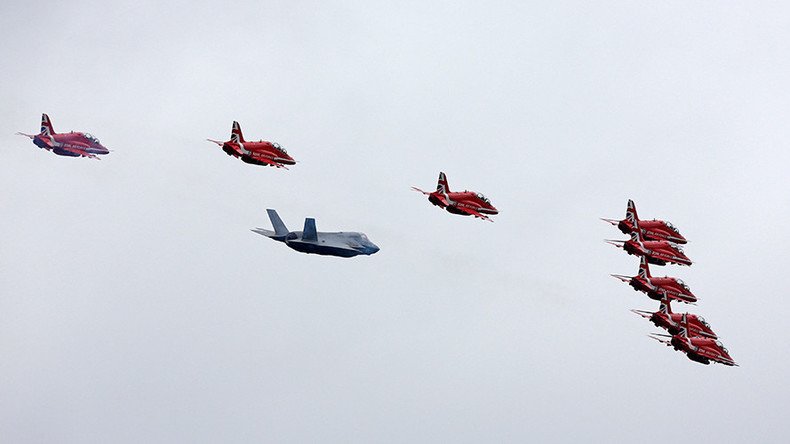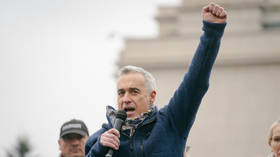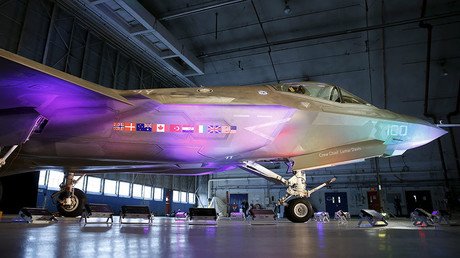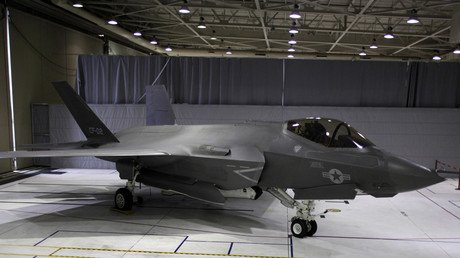Lockheed, could you spare a dime? Pentagon seeks F-35 savings

The US Department of Defense is looking to trim the fat from the F-35 fighter program, hoping to lower the price of the next-gen jet by $1.5 million apiece by 2019 and shave off $4 billion from a program with an estimated $1 trillion lifetime cost.
On Monday, the Pentagon announced a two-year extension of the Blueprint for Affordability cost-cutting program, first introduced in 2014, that would see Lockheed Martin and its sub-contractors invest $170 million into new technology, materials and manufacturing processes in order the reduce the cost of the fifth-generation fighter jet. The goal is to whittle down the cost of the F-35 from over $100 at the present to $85 million apiece by 2019.
The project funded 193 initiatives, of which 75 are still ongoing, the F-35 program office at the Pentagon told Reuters. The investments are expected to save between $1.15 million per aircraft in the ninth production batch, and $1.7 million each in the tenth.
The changes would amount to $4 billion in savings over the life of the program, the program office said.
From this morning: F-35 Lightning II flyby with the RAF Red Arrows to open Farnborough Air Show! #FIA16pic.twitter.com/KmWgO4v1Wq
— Military.com (@Militarydotcom) July 11, 2016
Even if the savings materialize, however, they will be a drop in the proverbial bucket for the program. Just the purchase of 2,457 warplanes will cost $379 billion, with the entire program estimated to run at over $1 trillion over its lifetime.
The US is also seeking to offset some of the cost by selling the F-35 to allied governments. Lockheed and the DOD are finalizing two contracts for 160 fighters, valued at over $14 billion, the Pentagon said Saturday.
A block purchase of F-35s by international customers would translate into another $2 billion in savings, Pentagon acquisition chief Frank Kendall told reporters. The DOD was “basically ready to move forward” on the block buy, he said. “We’d like to see that proceed as soon as possible."
The F35 armed with a full payload of soggy punters. #FIA16pic.twitter.com/PN5Q4HwfhI
— George Downs (@DownsDigital) July 11, 2016
Lockheed Martin’s CEO sounded enthusiastic Monday, speaking to CNBC as the F-35 made its debut at the Farnborough International Airshow in England, despite delays due to torrential rain.
“We are down 57 percent from the first aircraft that was delivered,” Marillyn Hewson told CNBC’s Worldwide Exchange show, “and we're on a path to be down to a price of an $85 million jet by 2019, which is comparable to a fourth generation aircraft.”
Hewson added, “you'll see a lot of countries that are actually increasing their defense spending because they need to address the threats that are out there.”
Seven of the nine governments that had pledged to buy F-35s have already received their first deliveries, according to Lockheed Martin. United Kingdom, Italy, the Netherlands, Canada, Turkey, Australia, Norway and Denmark all signed on to the initial partner agreement. Israel has also placed an order for a number of F-35s, which they will be allowed to modify and maintain on their own, unlike other countries.
Originally intended as the modular answer to the needs of the US Air Force, Navy and the Marine Corps, the F-35 has proven to be a colossal headache, not just in terms of consuming an increasing portion of the Pentagon’s budget. A litany of hardware, software, engineering and testing problems still awaits resolution, including ejection seats liable to severely injure or even kill pilots and buggy software that often requires pilots to reboot the radar in-flight.
“The F-35 program’s record of performance has been both a scandal and a tragedy with respect to cost, schedule, and performance,” Senator John McCain, chairman of the Armed Services Committee, said at a hearing in April, even as the Pentagon officials in charge of the F-35 maintained the program was “making solid progress in all areas."














